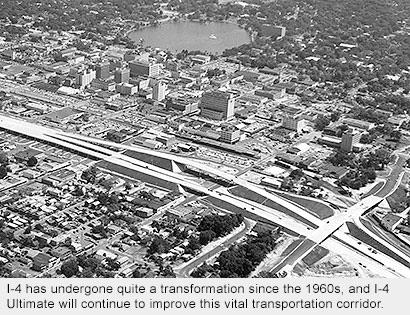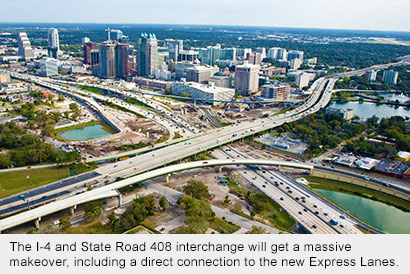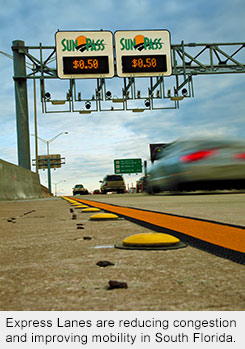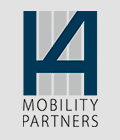|
|
|
|
How I-4 Became the Road Most Traveled
|
 |
|
Almost from its inception in 1965, I-4 has been Central Florida’s commuter road of choice. More than 4.5 million Americans made the Sunshine State their vacation destination in the 1950s, with many more becoming full-time Floridians. The decade saw a 79 percent population boom as the good times rolled into the post-World War II era.
A 1954 traffic study identified nearly 195,000 vehicle trips per day in and out of the metro Orlando/Winter Park area. Former President Dwight D. Eisenhower’s Federal-Aid Highway Act of 1956 gave civic leaders the financial backing they needed to build the then-named Orlando Expressway and shape the region for generations to come.
Work on the 8.2-mile interstate project from Rio Grande Avenue, just west of Orange Blossom Trail, to Lee Road began in 1958. Constructed in six segments, the $42.2 million highway was built to handle 70,000 vehicles per day through the downtown Orlando area when it opened in March 1965. I-4 currently handles more than triple that capacity!
The Orlando of today could draw similar comparisons to Ocala were it not for Walt Disney’s November of 1965 announcement that he planned to build a theme park “bigger and better than Disneyland.” From his experiences in California, Disney knew the effect highways had on an area. The freshly paved I-4 provided the perfect conduit for bringing his ambitious vision to life.
Walt Disney World drew 20 million visitors, and employed 13,000 people, in the first two years after opening in 1971. Sea World quickly followed in 1973. The City Beautiful was well on its way to becoming the theme park capital of the world, and I-4 congestion was already a concern.
By the time Universal Studios opened its doors in the early 1990s, roadway engineers were already designing new interchanges that could accommodate up to 10 lanes of traffic. Interim projects, including interchange enhancements and the addition of auxiliary lanes, provided little relief as the population in Orange, Seminole, Osceola and Lake counties swelled to more than 1.8 million by 2000 – an increase from a population of more than 450,000 in 1965.
The appeal of Central Florida isn’t expected to fade into the sunset anytime soon. Forbes magazine recently ranked the metro area the eighth best big city for jobs in the country. As Orlando continues to grow, I-4 Ultimate will meet the need for better transportation, providing motorists with more reliable travel times on the area’s most popular roadway.

|
|
|
How Much Do You Know About Express Lanes?
|
 |
| |
Did you know that drivers in Fords, Chevrolets, Toyotas, Hondas and Dodges are the most frequent users of Express Lanes? Or that Express Lanes users are overwhelmingly satisfied with the reduction in congestion, improvement in mobility and increase in trip reliability? Variably tolled Express Lanes are already managing congestion in South Florida but are a relatively new concept to Central Florida motorists. Keep reading to learn more about Express Lanes.
Express Lanes Benefit Everyone. People of all income levels use Express Lanes, and a driver’s decision to use the lanes is based on individual needs and traffic conditions — not income. When drivers choose to travel in the Express Lanes, congestion in the general use lanes is reduced as well.
Tolls Aren’t Taxes. Tolls and taxes have a fundamental difference — you have to pay your taxes! Drivers always have the option to stay in the general use lanes or take a different route. Taxes are used to pay for non-toll roads, and tolls are used to pay for the construction and maintenance of that facility.
Higher Toll Rates Do Not Equal Better Service. High toll amounts actually mean more cars are currently using the Express Lanes. When toll amounts are high, Express Lanes operators are trying to discourage drivers from entering the lanes so that drivers have a faster, more predictable trip. Express Lanes are a form of managed lanes, which help manage traffic efficiently.
More General Use Lanes Might Not Improve Mobility. If general use lanes were added under a traditional approach (which could take more than 20 years to complete), demand would far surpass the capacity before the project was complete. Express Lanes help ease congestion, move more people and offer a more reliable trip.
Tolls Help Pay for Our Roadways. America’s interstate system is aging and in need of repair. The 18.4-cent federal gas tax, which has historically funded maintenance and repairs but hasn’t been increased since 1993, is not enough to offset increasingly energy-efficient vehicles. Tolls have proven to be a convenient and fair method of raising revenues to complete much-needed work.
|
|
|
People Building a Better I-4:
I-4 Ultimate Public Information Officer Dave Parks
I-4 Ultimate will create thousands of jobs in Central Florida. This video series explores the wide variety of people and expertise needed to build a better I-4. Project Public Information Officer Dave Parks helps motorists understand what’s required for projects to go from concept to concrete and how each step along the way affects them on a daily basis. He discusses why he moved his family to Central Florida to be part of history in this month’s installment.
|
|
|
FDOT District Five Is on Social Media

 |
|
| |
The Florida Department of Transportation (FDOT) is taking to Twitter and Facebook in Central Florida, expanding the way residents and visitors can learn about important updates, milestones and need-to-know information on the I-4 Ultimate construction project. While Moving-4-ward.com remains the official source for anything and everything I-4 Ultimate, social media users can follow @MyFDOT_CFL on Twitter and like FDOT Central Florida on Facebook by visiting Facebook.com/MyFDOTCFL to stay up to date on timely project news, major roadway incidents and special project features. Posts about the I-4 Ultimate project include “#I4Ultimate,” so users can also search for the project hashtag to find all of the latest news.
The social media accounts also feature fun facts, safety tips and more to keep in mind during the length of the project. In addition to I-4 Ultimate info, you can find out about other projects in the area that may affect transportation in Central Florida. Don’t forget to keep an eye out for other social media platforms coming soon, like YouTube and Flickr.
|
|
|
|
|
|











